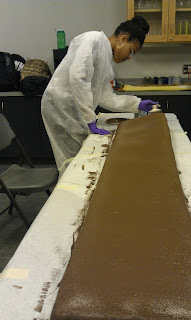We would like to Thank all of our followers and the assistance of everyone at the Carnegie Museum of Natural History, Carnegie Museum of Art and the Geology and Planetary Science Department at the University of Pittsburgh.
Our exhibit has 3 parts, a Lead Infographic, a texture soil column wall, and a brownfield map of the City of Pittsburgh.
 |
| One of our student interns preparing a panel for the textured soil column wall. |
The wall features the layers typical in a soil column. These layers are:
O Layer- Is the top layer, which is typically very thin and comprises Organic Matter.
A Layer - This layer is below the O layer and comprises a rich organic materials and minerals.
B Layer- This layer is primarily constructed out of clay.
C Layer- This layer is typically sandy and filled with slightly weathered parent material (Bedrock).
R Layer- The R layer is the bedrock layer.
The Lead Infographic shows the different ways that lead gets into our environment and bodies. This includes sources such as industrial, leaded gasoline, and leaded paint.
The final part of the exhibit is the Brownfield map. This map shows the historic brownfields in the City of Pittsburgh. Panels on the exhibit show what the brownfields looked like and what they have been turned into, whether it be a shopping center or a new research facility for Pitt, or a new residential development.



Thank you for the post Shopping for a green mattress by Natural Mattress Matters https://www.naturalmattressmatters.com/shopping-green-mattress/
ReplyDelete